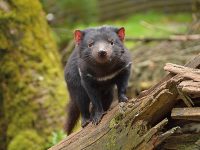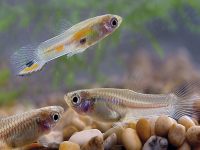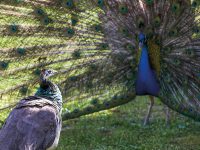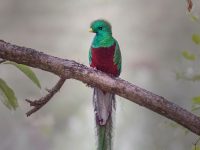Is beauty a criterion of truth?
Genetic quality or aesthetic criteria, drivers of sexual selection in animals
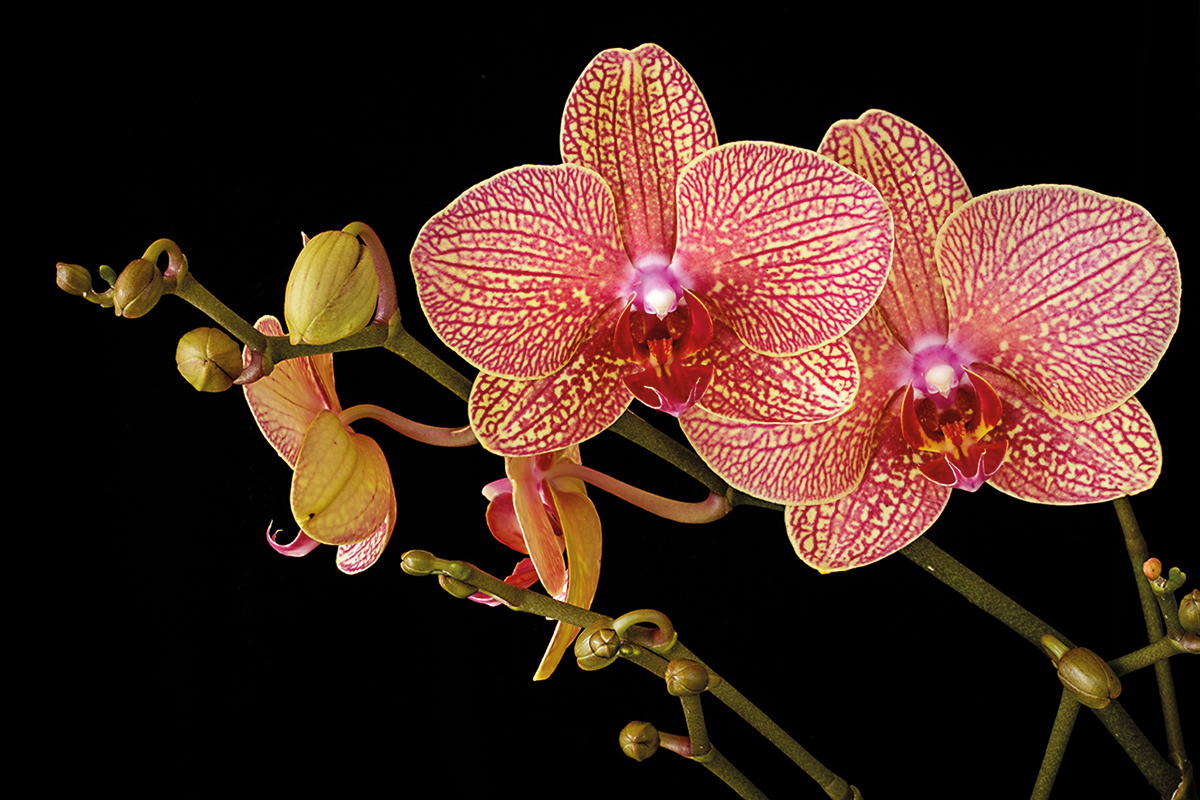
Do bees or hummingbirds perceive the beauty of the flowers they approach to take nectar? That is, can non-human animals appreciate beauty? Is there a universal truth regarding beauty? Or is it just a useful attribute, an indicator of a valuable trait? As with so many other natural phenomena, there is no simple answer to these questions. In the following document, we analyse different aspects of sexual selection and its connection (or lack thereof) to aesthetic criteria and the so-called handicap principle.
Keywords: sexual selection, beauty, evolutionary biology, evolution.
Anchiornis huxleyi was a crow-sized dinosaur whose fossil remains allowed experts to describe its plumage. It was predominantly grey, with a brown Mohawk-like crest and long white feathers with black marks at the end. Its feathers, wide and flat, were not good for flying.
Early-age down feathers would have helped Anchiornis huxleyi to insulate itself from the outside – to better protect itself against cold, humidity, or heat – and thus, keep its body temperature within comfortable limits. But down feathers are one thing and adult feathers are another, especially when they are large and brightly coloured. Richard Prum, the leader of the research team that published the discovery of the coloured feather remains, believes that the reason for their existence was purely and simply beauty. According to him, they were flashy just for the sake of beauty, to make them an object of admiration for members of the other sex. Thus, that would represent the same selective pressure driving the great aesthetic explosion in avian reptiles as well as, to a lesser extent, the evolution of other animal groups (Li et al., 2010).
Concerning beauty
Some 155 million years later, the males of thousands of bird species, heirs to those early feathered dinosaurs, display their ornaments to females to try to persuade them to mate with them. In addition to being beautiful, bird feathers, along with other anatomical and physiological features, would later facilitate their bearers’ flight. Therefore, aesthetics and usefulness converged to create birds’ plumages.
Just as Anchiornis was proudly showing off its plumage to the world some 150 million years ago, many plants depended on the wind to spread the pollen they generated in order to reproduce. But some insects began to feed on these protein-rich pollen grains and accidentally transported them from one plant to another. Fertilisation proved to be much more efficient this way. Thus, the most pollen-rich plants were particularly successful. So were the insects that were most adept at finding pollen.
In a process of co-evolution, some plants began to modify their leaves and so flowers emerged as structures to attract the attention of pollinators. Bold shapes and colours helped them stand out against the general green background. Their scents and light emission in a very wide range of frequencies – up to ultraviolet – generated a corresponding response from pollinators. Because their nectar provided an incentive in the form of additional energy intake, insects, birds, and mammals all began to compete for access, and so they developed wings, tongues, and brains better suited to the search for floral sustenance. As pressure from both sides intensified, plants and their pollinators established increasingly specific relationships, pushing each other to aesthetic and adaptive extremes. This produced, on the one hand, tiny birds that buzz and flutter like insects or, on the other, an orchid that mimics the look and smell of a female bee.
Millions of years later, flowers still fascinate us. We are captivated by their colours, shapes, and scents. But why do we like them so much? Do bees or hummingbirds consider them beautiful in the same way as we do when they approach to take nectar? Do any of the characteristics of flowers have a similar effect on them and us, and more generally, what is the essence of their beauty? Can non-human animals appreciate it? Is there a universal truth regarding beauty?
According to physicist David Deutsch (2011), such a truth exists: we like flowers because they are beautiful. Not because we think they are beautiful, but because they are. In his opinion, in addition to the subjective component, which depends on different circumstances affecting the observer, there is an objective component to beauty. Thus, according to him, the well-known adage «beauty is in the eye of the beholder»1 is not entirely true. The fact that humans like flowers would be proof that their beauty is an objective trait because we are attracted to them even if they do not provide us with a benefit equivalent to that of pollinators. Deutsch argues that the use of objective standards of beauty is the best way to develop hard-to-forge signals in the communication between living beings – flowers and pollinating insects, in this case. To him, the beauty of flowers would not be an accidental side effect, because the most replicated genes would be those that embody objective beauty. Later, in an interview for Nature by Kristin Sainani (2015), heeven claims that aesthetic truths are as objective as the laws of physics.
The perception of beauty
As in so many other cases, Charles Darwin had already addressed this question, in what was his second great contribution to the history of human thought, The descent of man. When discussing beauty, he stated the following:
Sense of beauty. — This sense has been declared to be peculiar to man. I refer here only to the pleasure given by certain colours, forms, and sounds, and which may fairly be called a sense of the beautiful; with cultivated men such sensations are, however, intimately associated with complex ideas and trains of thought. When we behold a male bird elaborately displaying his graceful plumes or splendid colours before the female, whilst other birds, not thus decorated, make no such display, it is impossible to doubt that she admires the beauty of her male partner. […] If female birds had been incapable of appreciating the beautiful colours, the ornaments, and voices of their male partners, all the labour and anxiety exhibited by the latter in displaying their charms before the females would have been thrown away; and this it is impossible to admit. (Darwin, 1877).
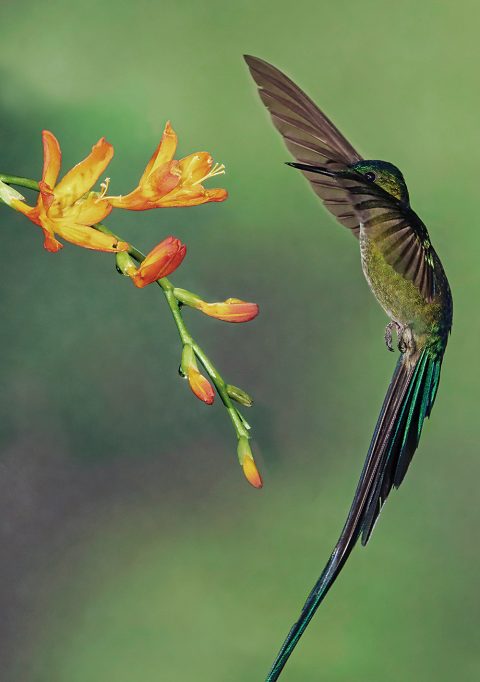
Do bees or hummingbirds perceive the beauty of flowers in the same way as humans do when they approach to take nectar? / Photo: Chris Charles
In that quote, and in numerous other passages from The descent of man, he made it clear that some animals have a sense of aesthetics and that, therefore, there is no difference between us and other animal species; that the spectrum that exists in nature also manifests itself in the sense of aesthetics. When expressing himself in these terms, Darwin was anthropomorphising; that is, he was attributing genuinely human traits to other species, simply because their behaviour appeared to dictate it. This is the opinion, for example, of the philosopher Anthony O’Hear (as cited in Buskes, 2006). However, in a matter such as this, is it possible to avoid anthropomorphism?
When we interact with another person, we are not certain that our perceptions and theirs, when faced with the same sensory stimuli, are the same. Since we belong to the same species, it is normal to think that, given a particular stimulus, our receptors will respond in a very similar way. But reception is one thing and perception is another. The latter involves experience, memory, culture, and even the mood or the emotional state of a subject at the moment they perceive a stimulus. This occurs in a variety of ways, from top-down control by the encephalic processing centres over the sensory filtering systems in the receptors, to the centralised elaboration of perceptions involving different subsystems or circuits. Perception turns sensory stimuli into mental states; generates images, sounds, smells, and much more, in a way that is highly dependent on the information contained in the brain beforehand2 (Kandel, 2016).
If, instead of individuals belonging to the same species, they belong to two different species, things will be even more different, so one might even ask whether their perceptual experiences are in any way similar, or at least equivalent. In this case, trying to put ourselves in the other individual’s shoes would make no sense. The philosopher Thomas Nagel referred to this impossibility or difficulty almost half a century ago, when he asked in an article (one that is now a cult piece) «What is it like to be a bat?» (Nagel, 1974).
Nagel points out that if he tries to imagine what being a bat is like for a bat, he is limited to the resources of his own mind, «and those resources are inadequate to the task». That is, there may be facts about bats for which human beings lack the concepts that would allow us to represent or understand them. Moreover, there may be events which we would never be able to represent or understand in our minds, even if we lived forever, simply because our structure does not allow us to use the necessary concepts to do so. Furthering the paradox, he asks: what can we understand as the objective features of an experience when we have no access to it? «What would be left of what it was like to be a bat if one removed the viewpoint of the bat?», he asks. Just as it is not possible to access the bat’s perceptual experience, neither are we in a position to attribute the ability to experience human-like perceptions to beings of other sentient species. In this sense, the notion of umwelt (“environment or surroundings” in German) is very useful. The term refers to the subjective world of perception. As Antonio José Osuna (2017) says, there is an umwelt for each species or organism; in turn, umwelten refers to the different perceptual worlds in which species live. The umwelt represents an organism’s model of the world; each of its functional components, which roughly correspond to perceptual characteristics, has a meaning for the organism. Indeed, Nagel discusses (without using the term) the umwelt of bats compared to humans.
At this point, we have two alternatives. One is to forgo further analysis. The other is to inquire into the nature of other species’ perceptions of what we humans judge to be beautiful. To this end, the most operative thing to do is to assess, based on their definition, whether what beings with very different umwelten perceive is equivalent to our experienced perception. The point, therefore, is not to attribute our own perceptual experience to, say, a bat, but to inquire into its central nervous system processing and its implications. This is because, if the circuits involved in that perception perform tasks equivalent to our own, we would be entitled to think that they might respond in a similar way.
According to Wikipedia, «beauty is commonly described as a feature of objects that makes these objects pleasurable to perceive». The Royal Spanish Academy defines beautiful as «that which, due to the perfection of its forms, pleases the eye or ear and, by extension, the spirit». The online version of the OED defines beauty as «the quality of giving pleasure to the senses or to the mind». Finally, in a more formal context, Chatterjee et al. (2022) noted that «we regard aesthetics broadly to encompass interactions with entities or events that evoke intense feelings and emotions, typically linked to pleasure, including but not limited to engagement with art». In all these cases, reference is made to the satisfaction produced by that which is beautiful. They introduce us to the neurophysiology of pleasure and motivation. Knowledge in this field means we know that reward circuits are activated in non-human animals in response to the reception of visual, auditory, or olfactory signals emitted by other members of the same species in order to express preferences and form reproductive partners (DeAngelis & Hofmann, 2020; Hoke et al., 2004). This implies that, if we speak of other animal species’ perceptions of beauty, we must go beyond visual or auditory perception and include all possible forms of sensory reception.
Along these lines, and referring explicitly to the origins of aesthetic appreciation, Nadal and Cela-Conde (2022) state that «we share many of the neural systems that mediate the cognitive and affective processes involved in aesthetic appreciation with many other animals, primate and otherwise». They also point out that:
Much of the neural machinery that makes it possible for us to experience beauty existed millions of years before the origins of the human lineage: it is part of the «basic cognitive kit» that enables mammals – maybe even birds and reptiles – to assess the value of meaningful current or possible objects and situations in the light of past experience and current state. What we thought of as «the human capacity to produce and appreciate beauty» we now see as one among many variations on the theme of a hedonic valuation system; that is to say, a system of brain regions shared across many species that informs the organism how much it likes or wants something. (Nadal & Cela-Conde, 2022).
Also in this line, Brown (2022) proposed that the aesthetic system of the brain originally evolved to evaluate objects of biological importance – especially food sources and potential mates – and was later co-opted for the appreciation of works of art, such as paintings and music.
Therefore, if species as distant from each other as humans and, for example, the túngara frog, process stimuli that they consider pleasurable in functionally equivalent circuits, we can conclude that, in both species, they can give rise to similar levels of attraction behaviour, and that that behaviour can lead to something equivalent to the perception of beauty. We must heed, however, O’Hear’s warning (quoted in Buskes, 2006): the fact that the qualitative evaluation of sensory stimuli occurs on functionally equivalent neurological substrates is no indication of anything regarding the mental experiences themselves, so a reductionist approach cannot explain the sense of beauty.
The usefulness of beauty
In The descent of man, Darwin dealt not only with the origin of humans, but also elaborated on his observations concerning the mechanism through which animals acquire secondary sexual traits, mainly ornaments. He called this mechanism sexual selection. In his own words:
There are many other structures and instincts which must have been developed through sexual selection – such as the weapons of offence and the means of defence of the males for fighting with and driving away their rivals – their courage and pugnacity – their various ornaments – their contrivances for producing vocal or instrumental music – and their glands for emitting odours, most of these latter structures serving only to allure or excite the female. It is clear that these characters are the result of sexual and not of ordinary selection, since unarmed, unornamented, or unattractive males would succeed equally well in the battle for life and in leaving a numerous progeny, but for the presence of better endowed males. (Darwin, 1877).
Thus, sexual selection comprises two different and potentially conflicting mechanisms. The first, which Darwin called the law of battle, was the struggle between individuals of the same sex – usually males – to sexually control those of the other sex. The second, which he called the taste for the beautiful, referred to the process by which members of one sex – usually females – choose their partners based on innate preferences. The ornamental features become the criteria for attraction that guide females. They range from bird songs, colourful plumage and displays, to the bluish face and hindquarters of the Mandrillus sphinx mandrill.
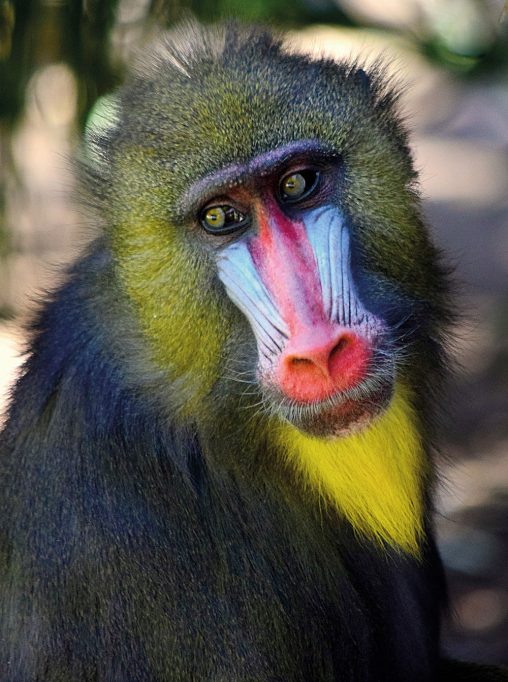
Under sexual selection, the members of one sex – usually females – choose their partners based on innate preferences. In the case of the mandrill (Mandrillus sphinx), the ornamental features that determine these preferences are their bluish face and hindquarters. / Photo: Meg Jerrad
With sexual selection, Darwin found an explanation for traits that made no sense to him under natural selection. As he wrote to botanist Asa Gray on 3 April 1860: «The sight of a feather in a peacock’s tail, whenever I gaze at it, makes me sick!» (Darwin, 1860). He did not understand how very garish traits, some of which might even compromise the survival of their bearer, had been selected when they provided no survival advantage whatsoever. Until he realised that the key was reproduction: males that reproduced left offspring, so female choice conditioned the entire process.
From the moment Darwin published his theory of sexual selection, he came under heavy criticism. It was not easy to accept that females were guided by aesthetic criteria when selecting a breeding mate and that this choice was an evolutionary mechanism in itself. One of the most significant opponents of the theory was Alfred Russel Wallace. On the one hand, Wallace was sceptical of the possibility that animals had sensory and cognitive capacities allowing them to make mating choices. On the other hand, he believed that human beings were created by God in a special way and were endowed with cognitive abilities that non-human animals lack. Moreover, he was convinced that the only way in which the facts he observed could be explained was by assuming that animal colour and ornamentation were strictly correlated with health, vigour, and the general fitness necessary for survival.
As early as the early 20th century, the statistician and geneticist Ronald Fisher proposed that, given a certain preference among the selecting sex for an ornamental trait, such preferences would confer a reproductive advantage onto individuals possessing it. This would trigger what has come to be known as runaway selection, whereby selected traits would be exaggerated generation after generation, to the point where they would become ostentatious, like the tails of peacocks (Pavo cristatus); elaborate, like the dances of manakins (Pipridae family); or sophisticated, such as in the constructions of bowerbirds (Ptilonorhynchidae family), to name but a few emblematic examples. However, during the 20th century, there was strong resistance to Fisher’s model, based largely on Wallace’s objections to the original proposal made by Darwin.
The landscape changed with the publication of a proposal that sought to show the compatibility of runaway selection with the ultimate usefulness of selected traits (Zahavi, 1975): the handicap principle. According to this principle, sexual selection is effective because it improves the ability of the selecting sex to detect quality in the selected sex; the more elaborate a trait is, the higher its costs; the greater the handicap, the more rigorous the test, and therefore the better the sexual partner. In fact, females attracted to males with such costly traits would not respond to beauty (per se) but rather, to what such beauty indicates about the male’s ability to overcome those costs.
Nonetheless, the handicap principle has not closed the debate on the real meaning of male ornaments and female mate selection. According to Prum (2012), the trait that females select for is beauty, in the terms in which sexual selection was formulated by Darwin in The descent of man. According to Prum, Zahavi’s (1975) proposal should be considered «neo-Wallacean» (Prum, 2017). He believes that, by using terms like beauty, taste, charm, appreciate, admire, and love, Darwin meant to suggest that mating preferences may have arisen without any utility to the individual selector, only aesthetic value; in other words, that beauty would have arisen because it was pleasurable to the observer. Prum, who has studied the great diversity and complexity of the courtship dances of male manakins in the jungles of Mesoamerica, believes that if traits developed through sexual selection are attributed a diagnostic value for genetic quality, such values should be attributed to each element of those traits and not just to the fact that they are complex and elaborate. This is no small point.
In a published review of sexual selection, Juan Moreno (2013) argues that it is not correct to claim that Darwin advocated mate selection according to purely aesthetic criteria, nor that there was a great difference between Darwin and Wallace’s views. He provides quotes from The descent of man which leads him to conclude that «for Darwin, sexual selection was not a capricious contest of fashions, but rather the manifestation of female preference for the best-endowed suitors».
«With sexual selection, Darwin found an explanation for traits that made no sense to him under natural selection»
Along these lines, Gerald Borgia, perhaps the ornithologist with the most extensive knowledge about the behaviour and biology of bowerbirds, found that males who are better problem solvers are also more attractive to females. This makes sense because the ability to solve problems reflects the level of cognitive skills, and these, in turn, impact the complexity and degree of elaboration in terms of the bowers they build. Thus, females are guided by the bower when selecting a male because, ultimately, this criterion refers to cognitive abilities whose effects must also encompass functions directly related to biological fitness (Keagy et al., 2009; 2011). Given that construction of the bower requires resources and dedication that thus, cannot be allocated to essential or simply important functions, this is a clear example of the handicap principle in action.
However, a more recent meta-analysis of 90 studies, involving a total of 55 species from different taxa, did not provide support for the handicap principle, although it did find positive correlations between the attractiveness of the selected male and certain offspring traits, such as immunocompetence and fitness (Prokop et al., 2012). Finally, Rosenthal and Ryan (2022) found that the developmental trajectory of sensory systems, diet, predation risk, pathogen infection, and maternal hormone transfer to offspring, among other factors, can have an important effect on male mate selection. They argue that, for this and other reasons, reproductive mate selection is a much more complex process than Darwin expressed in his work, and which has been simply accepted ever since.
Is beauty a criterion of truth?
In the debate regarding the character and meaning of the selection of beautiful features, there are echoes of the last lines of John Keats’ famous poem Ode on a Grecian urn: «Beauty is truth, truth beauty, – that is all / Ye know on earth, and all ye need to know». In this case, the «beauty» is that of the reproductive partners chosen for their attractiveness, while the «truth» refers to the honesty of the visual, olfactory, or auditory signals with which they try to convince the other partner to mate with them.
However, no unambiguous answer exists to this question. As with so many other natural phenomena, there is no basis for choosing between one of two extreme categories. Most likely there are species in which the traits selected were indeed chosen because they were sincere indicators of «good genes». While in other cases, the perceptual biases mentioned by Ryan (2018) may have conditioned the selection process. In still other cases, for the aforementioned or different reasons, the «aesthetic» criterion may have been at work, in a process of Fisherian runaway evolution leading to spectacular displays, without them necessarily being indicators of genetic quality.
Two centuries after Keats wrote his ode, we still do not know whether or not beauty is a criterion of truth in the matter at hand. But the century and a half since the publication of The descent of man has not been for nothing: we know much more, and the frontier of what we do not know is much more distant.
Notes
1. The sentence has been attributed to different sources but was apparently taken from Margaret Wolfe Hungerford’s 1878 novel Molly Bawn, perhaps based on Shakespeare’s Love’s labour’s lost (1588), «beauty is bought by judgement of the eye). (Go back)
2. For the reasons given above, and for the purpose of this text, the expression by Margaret Wolfe Hungerford quoted above («beauty is in the eye of the beholder»), should be replaced by the following one by David Hume: «Beauty in things exists merely in the mind which contemplates them». (Go back)
Acknowledgements
I would like to thank Antonio José Osuna and Xurxo Mariño for their critical reading and comments on a first draft of this text. Any errors or inaccuracies that may have slipped by are the sole responsibility of the author.
References
Brown, S. (2022). Naturalizing aesthetics. In A. Chatterjee & E. R. Cardillo (2022), Brain, beauty, & art: Essays bringing neuroaesthetics into focus (pp. 18–21). Oxford University Press. https://doi.org/10.1093/oso/9780197513620.003.0004
Buskes, C. (2006). Evolutionair denken: De invloed van Darwin op ons wereldbeeld. Uitgeverij Nieuwezijds.
Chatterjee, A., & Cardillo, E. R. (2022). Prologue: Where have we been, and where are we now? In A. Chatterjee & E. R. Cardillo, Brain, beauty, & art: Essays bringing neuroaesthetics into focus (pp. XI–XII). Oxford University Press.
Darwin, C. (1860, 3 April). Letter to Asa Gray. Darwin Correspondence Project. https://www.darwinproject.ac.uk/letter/DCP-LETT-2743.xml
Darwin, C. (1877). The descent of man, and selection in relation to sex. John Murray.
DeAngelis, R. S., & Hofmann, H. A. (2020). Neural and molecular mechanisms underlying female mate choice decisions in vertebrates. Journal of Experimental Biology, 223(17), jeb207324. https://doi.org/10.1242/jeb.207324
Deutsch, D. (2011). The beginning of infinity. Explanations that transform the world. Viking.
Hoke, K. L., Burmeister, S. S., Fernald, R. D., Rand, A. S., Ryan, M. J., & Wilczynski, W. (2004). Functional mapping of the auditory midbrain during mate call reception. Journal of Neuroscience, 24(50), 11264–11272. https://doi.org/10.1523/JNEUROSCI.2079-04.2004
Kandel, E. R. (2016). Reductionism in art and brain science. Bridging the two cultures. Columbia University Press.
Keagy, J., Savard, J.-F., & Borgia, G. (2009). Male satin bowerbird problem-solving ability predicts mating success. Animal Behaviour, 78(4), 809–817. https://doi.org/10.1016/j.anbehav.2009.07.011
Keagy, J., Savard, J.-F., & Borgia, G. (2011). Complex relationship between multiple measures of cognitive ability and male mating success in satin bowerbirds, Ptilonorhynchus violaceus. Animal Behaviour, 81, 1063–1070. https://doi.org/10.1016/j.anbehav.2011.02.018
Li, Q., Gao, K.-Q., Vinther, J., Shawkey, M. D., Clarke, J. A., D’Alba, L., Meng, Q., Briggs, D. E., & Prum, R. O. (2010). Plumage color patterns of an extinct dinosaur. Science, 327(5971), 1369–1372. https://doi.org/10.1126/science.1186290
Moreno, J. (2013). Evolución por selección sexual según Darwin. La vigencia de una idea. Síntesis.
Nadal, M., & Cela-Conde, C. J. (2022). Bringing it all together. Neurological and neuroimaging evidence of the neural underpinnings of visual aesthetics. In A. Chatterjee & E. R. Cardillo, Brain, beauty, & art: Essays bringing neuroaesthetics into focus (pp. 8–11). Oxford University Press. https://doi.org/10.1093/oso/9780197513620.003.0002
Nagel, T. (1974). What is it like to be a bat? The Philosophical Review, 83(4), 435–450. https://doi.org/10.2307/2183914
Osuna, A. J. (2017, 17 September). Antropomorfismo [conference session]. Naukas, Bilbao. https://www.eitb.eus/es/divulgacion/naukas-bilbao/videos/detalle/5082718/video-naukas-bilbao-2017-antonio-j-osuna-biotay-antropomorfismo/
Prokop, Z. M., Michalczyk, L., Drobniak, S. M., Herdegen, M., & Radwan, J. (2012). Meta-analysis suggests choosy females get sexy sons more than «good genes». Evolution, 66(9), 2665–2673. https://doi.org/10.1111/j.1558-5646.2012.01654.x
Prum, R. O. (2012). Aesthetic evolution by mate choice: Darwin’s really dangerous idea. Philosophical Transactions of the Royal Society B, 367(1600), 2253–2265. https://doi.org/10.1098/rstb.2011.0285
Prum, R. O. (2017). The evolution of beauty: How Darwin’s forgotten theory of mate choice shapes the animal world – and us. Anchor.
Rosenthal, G. G., & Ryan, M. J. (2022). Sexual selection and the ascent of women: Mate choice research since Darwin. Science, 375(6578), eabi6308. https://doi.org/10.1126/science.abi6308
Ryan, M. J. (2018). A taste for the beautiful. Princeton University Press.
Sainani, K. (2015). Q&A: David Deutsch. Nature, 526, S16. https://doi.org/10.1038/526S16a
Zahavi, A. (1975). Mate selection – a selection for a handicap. Journal of Theoretical Biology, 53, 205–214. https://doi.org/10.1016/0022-5193(75)90111-3

